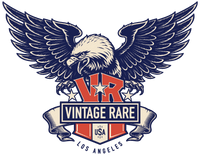Vintage Harley Davidson & 3D Emblem Tee Shirt Label History since 1960S - Vintage Rare USA
Harley-Davidson is one of the most iconic names in American motorcycling, with a legacy that dates back to 1903. Founded in Milwaukee, Wisconsin, by William S. Harley and the Davidson brothers (Arthur, Walter, and William A.), the company started with a small engine prototype and quickly grew into a symbol of freedom, rebellion, and Americana.
Harley-Davidson bikes gained fame for their rugged design, powerful V-twin engines, and deep, distinctive rumble. They were widely used by the U.S. military in both World Wars, which helped solidify their legendary status. Through the decades, Harley became not just a motorcycle brand, but a lifestyle—embodying the spirit of the open road.
From vintage Knuckleheads and Panheads to modern-day touring bikes, Harley-Davidson has weathered economic downturns, competition, and cultural shifts while staying true to its roots. Today, vintage Harley gear, from leather jackets to dealership tees, is highly collectible and remains a staple in both motorcycle and fashion history.
There are two main ways to identify the date of a Harley Tee Shirt:
- By looking at the label (detailed in the next section)
- By looking at the copyright
1960s: Early Merch & Simplicity
-
Label Style:
- Very few standardized Harley labels existed; many shirts were custom printed by local dealerships or events.
- Tees were often tagless or featured generic blank labels (like Champion, or unbranded tags).
-
Made in USA with Single Stitch Sleeves
-
Notable Features:
- T-shirts were typically basic cotton blanks with single-color prints—often dealership logos or small bar & shield emblems.
- These early tees are extremely rare, often worn hard and rarely preserved.
- Sizing was small by modern standards, and cuts were tighter.



1970s: The Beginnings of Branded Merch
-
Label Style:
-
Tees were often printed on blank bodies from companies like Hanes or Screen Stars, Champion OR Collegiate Pacific.
- Some tees from this era were tagless or had minimal branding, especially if produced in limited runs or by small local dealers.
-
-
Made in USA with Single Stitch Sleeves
-
Notable Features:
- Graphics were typically single-color prints or simple logos—very collectible today due to rarity and age.
1980s: Rise of Dealership Tees & Bold Graphics
-
Label Style:
- Introduction of custom Harley-Davidson branded tags, often black with the orange and white bar & shield logo.
- Some tees still used blanks (like Screen Stars, Hanes, or Anvil) but with Harley-specific graphics printed by dealerships.
- Some Tees are using the 3D Emblem Label
-
Made in USA with Single Stitch Sleeves
-
Notable Features:
- Tees often featured bold front prints and a dealer/location hit on the back (e.g., "Harley-Davidson of Daytona Beach").
- Soft, lightweight cotton became popular—many used 50/50 blends.
- Collectors love the regional and limited-edition designs from this era.


1990s: Iconic Logo Tees & Mass Popularity
-
Label Style:
- Woven neck tags became more polished, often with a centered Harley logo and sometimes a registered trademark ®.
- Tags might say “Harley-Davidson Motor Clothes” or list specific licensing info.
-
Made In: Mostly Made in USA with Single Stitch Sleeves, but some production began shifting to Mexico and Canada by the late '90s.
-
Notable Features:
- Tees were heavier weight, often pre-shrunk cotton, with large back prints and chest logos.
- This decade gave us legendary graphics—eagles, flames, skulls, and choppers.
- Biker rally tees (like Sturgis, Laconia) became super collectible.
2000s: End of an Era for Made in USA
-
Label Style:
- Continued use of bar & shield branded tags, often with more legal/licensing information.
- Some labels added care instructions or size info in multiple languages.
-
Made In: Most Production Made In USA stopped around 2010. Many shirts by this point were Made in Mexico, Honduras, or Dominican Republic. No more Single Stitch Sleeves
-
Notable Features:
- Still featured great prints and detailed artwork, but mass production increased.
- Made in USA tags from this era are now considered end-of-era vintage and more desirable to collectors.


































